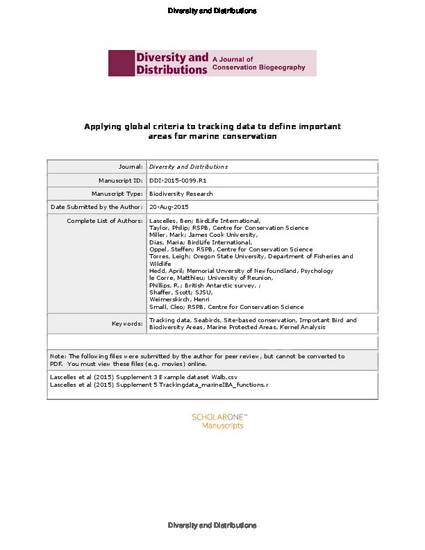
Article
Applying global criteria to tracking data to define important areas for marine conservation
Diversity and Distribution
(2016)
Abstract
Aim Enhanced management of areas important for marine biodiversity are now obligations under a range of international treaties. Tracking data provide unparalleled information on the distribution of marine taxa, but there are no agreed guidelines that ensure these data are used consistently to identify biodiversity hotspots and inform marine management decisions. Here, we develop methods to standardize the analysis of tracking data to identify sites of conservation importance at global and regional scales. Location We applied these methods to the largest available compilation of seabird tracking data, covering 60 species, collected from 55 deployment locations ranging from the poles to the tropics. Methods Key developments include a test for pseudo-replication to assess the independence of two groups of tracking data, an objective approach to define species-specific smoothing parameters (h values) for kernel density estimation based on area-restricted search behaviour, and an analysis to determine whether sites identified from tracked individuals are also representative for the wider population. Results This analysis delineated priority sites for marine conservation for 52 of the 60 species assessed. We compiled 252 data groupings and defined 1052 polygons, between them meeting Important Bird and Biodiversity Area criteria over 1500 times. Other results showed 13% of data groups were inadequate for site definition and 10% showed some level of pseudo-replication. Between 25 and 50 trips were needed within a data group for data to be considered at least partially representative of the respective population. Main conclusions Our approach provides a consistent framework for using animal tracking data to delineate areas of global conservation importance, allowing greater integration into marine spatial planning and policy. The approaches we describe are exemplified for pelagic seabirds, but are applicable to a range of taxonomic groups. Covering 4.3% of the oceans, the sites identified would benefit from enhanced protection to better safeguard the threatened species populations they contain.
Copyright of Diversity & Distributions is the property of Wiley-Blackwell and its content may not be copied or emailed to multiple sites or posted to a listserv without the copyright holder's express written permission. However, users may print, download, or email articles for individual use. This abstract may be abridged. No warranty is given about the accuracy of the copy. Users should refer to the original published version of the material for the full abstract. (Copyright applies to all Abstracts.)
Disciplines
Publication Date
April, 2016
DOI
10.1111/ddi.12411
Publisher Statement
This is the Accepted Manuscript of an article that appeared in Diversity and Distribution, volume 22, issue 4, 2016. The Version of Record (VOR) may be found at http://dx.doi.org/10.1111/ddi.12411
SJSU Users: use the following link to login and access the article via SJSU databases.
Citation Information
Ben Lascelles, P. R. Taylor, M. Miller, M. P. Dias, et al.. "Applying global criteria to tracking data to define important areas for marine conservation" Diversity and Distribution Vol. 22 Iss. 4 (2016) p. 422 - 431 ISSN: 1366-9516 Available at: http://works.bepress.com/scott_shaffer/47/
